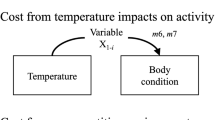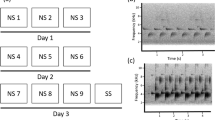Summary
I removed resident pairs of great tits from their territories for short periods and released them after replacement pairs had occupied the spaces. When two pairs are manipulated in this way into occupying the same territory an escalated contest ensures. Contests between residents and replacements are longer, more likely to involve physical fights and longer fights or displays than contests between established neighbours or residents and intruders. The degree of escalation between residents and replacements is an increasing function of replacement time. It rises to a peak and then diminishes again. The probability that the replacement will defeat the former resident is an increasing function of replacement time, reaching 90% after several days. These results are consistent with the hypothesis that territorial residents win in contests against intruders because of an asymmetry in payoff rather than an asymmetry in resource holding potential or an arbitary convention. A possibly asymmetry in payoff in the great tit is the cost of defending the territory against neighbours. The cost is higher for replacements than for residents.
Similar content being viewed by others
References
Blurton Jones, NG (1968) Observations and experiments on causation of threat displays of the great tit, Parus major. Anim Behav Monogr 1:75–158
Colgan PW, Nowell WA, Gross MR, Grant JNA (1979) Aggressive habituation and rim circling in the social organisation of bluegill sunfish (Lepomis macrochirus). Environ Biol Fish 4:29–36
Davies NB (1978) Territorial defence in the speckled wood butterfly (Paraarge aegeria): the resident always wins. Anim Behav 26:138–147
Davies NB, Houston AI (1981) Owners and satellites: the economics of territory defence in the pied wagtail Motacilla alba. J Anim Ecol 50:157–180
Dhondt AA (1971) Some factors influencing territory in the great tit Parus major. Gerfaut Rev Sci Belge Ornithol 61:125–135
Falls JB (1969) Functions of territorial song in the white-throated sparrow. In: Hinde RA (ed) Bird vocalisations. Cambridge University Press, Cambridge, pp 207–232
Garnett MC (1981) Body size, its heritability and influence on juvenile survival among great tits Parus major. Ibis 123:31–41
Gill FB, Wolf LL (1977) Non-random foraging by sunbirds in a patchy invironment. Ecology 58:1284–1296
Hammerstein P (1981) The role of asymmetries in animal contests. Anim Behav 29:193–205
Hammerstein P, Parker GA (1982) The asymmetric war of attrition. J Theor Biol (in press)
Harris MP (1970) Territory limiting the size of the breeding population of the oystercatcher (Haematopus ostralegus) — a removal experiment. J Anim Ecol 39:707–713
Howard RD (1978) The evolution of mating strategies in bull-frogs, Rana catesbiana. Evolution 32:850–871
Hyatt GW, Salmon M (1978) Combat in fiddler crabs Uca pugilator: a quantitative analysis. Behaviour 65:182–211
Kacelnik A, Krebs JR (in press) The dawn chorus of the great tit: a causal and functional analysis Behaviour
Kamil AC (1978) Systematic foraging for nectar by Amakihi Loxops virens. J Comp Physiol 92:388–396
Krebs JR (1971) Territory and breeding density in the great tit Parus major L. Ecology 52:2–22
Krebs JR (1977) Song and territory in the great tit. In: Stonehouse B, Perrins CM (eds) Evolutionary ecology, Macmillan, London, pp 47–62
Krebs JR, Perrins CM (1977) Behaviour and population regulation in the great tit (Parus major). In: Ebling FJ, Stoddart DM (eds) Population control by social behaviour. Inst Biol, London
Maynard Smith J (1976) Evolution and the theory of games. Am Sci 64:41–45
Maynard Smith J, Parker GA (1976) The logic of asymmetric contests. Anim Behav 24:159–175
Metzgar LA (1967) An experimental comparison of screech owl predation on resident and transient white-footed mice. J Mammal 48:387–390
Parker GA (1974) Assessment strategy and the evolution of fighting behaviour. J Theor Biol 47:223–243
Parker GA, Rubenstein DI (1981) Role assessment, reserve strategy and acquisition of information in asymmetric animal conflicts. Anim Behav 29:211–240
Patterson I (1980) Territorial behaviour and the limitation of population density. Ardea 68:53–62
Phillips RR (1971) The relationship between social behaviour and the use of space in the benthic fish Chasmodes bosquianus Lacepede (Teleosti: Bleniidae) II. The effect of prior residency on social and enclosure behaviour. Z Tierpsychol 29:289–408
Riechert SE (1978) Games spiders play: behavioural variability in territorial disputes. Behav Ecol Sociobiol 3:135–162
Sibly RM, McFarland DJ (1976) On the fitness of behaviour sequences. Am Nat 110:601–617
Wilson ED (1975) Sociobiology: the new synthesis. Belknap Press, Harvard
Zayan RC (1975) Modification des éffets liés a priorité de residence chez Xiphophorus (Pisces: Poecilidae): le rôle des manipulations experimentales. Z Tierpsychol 39:463–491
Author information
Authors and Affiliations
Rights and permissions
About this article
Cite this article
Krebs, J.R. Territorial defence in the great tit (Parus major): Do residents always win?. Behav Ecol Sociobiol 11, 185–194 (1982). https://doi.org/10.1007/BF00300061
Received:
Accepted:
Issue Date:
DOI: https://doi.org/10.1007/BF00300061




